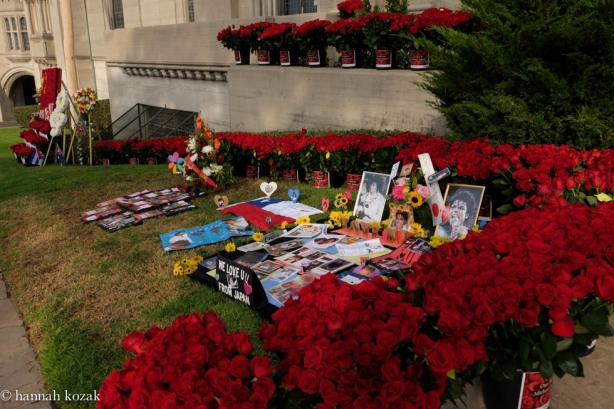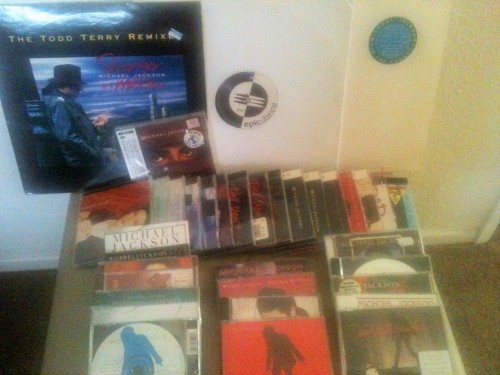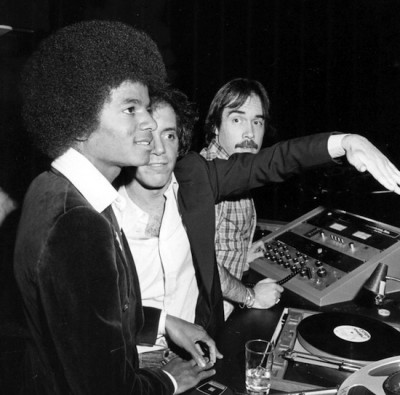Okay – after reading yet another snarky (and petty) criticism of Michael Jackson using playback in his tour performances, the practice commonly referred to by the moral majority as “lip-syncing”, I’m going to say it again: His reasons were good ones and understandable ones.
I’m gonna jump in here and share my opinion, with utmost respect to you all, because I’m the one with years of experience in theatre and music, working with performers and singers. Yes – I aim to defend. It’s a simple question but has a complicated answer.
Like many, you may have gotten your definition of “playback singer” – from Wikipedia – and of course it’s quite correct. However, the word “playback” is often used interchangeably (but inaccurately) simply to describe lip-syncing, which means moving the mouth but issuing no sound.
No matter though. Let’s be more accurate, especially in Michael Jackson’s particular case, and call it what it is instead: “singing over backing tracks”.
We do have to remember that MJ grew up on television as much as in live performance, and actual lip-syncing was extremely common and widely accepted for many reasons. Whether as J5 or Jacksons or young MJ solo, they all lip-synced many times. That’s how MJ got so good at it – that and his extreme consistency in performing his songs. It was SOP for “Soul Train” and “American Bandstand”, among many other groundbreaking musical shows.
(Aside: I never really have understood where MJ got the idea that his audiences would fall apart if they didn’t hear his big hits exactly as they had heard them on recordings the first time… he even mentions that during a rehearsal recorded on “This Is It”. But he got in that groove and never wavered, even when transposition of his songs downward in key would have suited his deep adult voice better. Not to use that deep voice in public was of course his other unusual choice. I also think a bit of public improvisation on his part would have been well received, interesting, and would have shown off his strong musicality. He apparently did not agree!)
Fast-forward to MJ on his first solo world tour, the Bad Tour, late 80’s. What jumps out at me after viewing concert footage is that he honestly tries to sing full out, every song, and dance full out, every number, for two-plus hours. Even at his physical peak during that tour, there were many musical phrases he simply dropped because he was concentrating on movement rather than singing at that moment. That’s the choice he had to make then and also going forward, given his overriding desire to make his fans happy – he could either sing it all or dance it all, or parts of each – but not all of both.
By the Dangerous Tour, early 90’s, he had started to use “singing over backing tracks” more and the simple physical and energetic demand of his performances was one big reason he went there. Even though a life-long athlete (with proof given in his autopsy report) he was still a human being. And all eyes and ears in those huge venues were focused upon one man – not on the band, not on the back-up singers, not on the dancers; though he chose the best he could find, they were the best-paid invisible men and women in the business. The audiences were there for Michael Jackson. He was onstage dancing and singing almost every minute and usually drenched in sweat from his efforts.
Concert footage really gives another perspective; one look at the energy exchange that went on between him and his audiences and we see that he indeed operated at something beyond that human level – he generated that signature energy and they threw it back to him, a loving and powerful closed-loop feedback system hot-wiring everyone at every performance. Maintaining that level took its toll.
After the shocking events of 1993 started to affect his personal life and would not go away, MJ faced other physical challenges such as persistent insomnia and autoimmune disease. FACT: Singers and their voices are not two independent things; what affects the singer, affects the voice. You can’t separate them. His emotionally challenging personal life all through the 90’s most certainly had physical consequences.
And as MJ went on his third solo world tour, History, he was nearing 40 and inevitably hadn’t the same physical stamina level. By this time the relentless media attacks on him were having visible personal and financial repercussions. The injustice of this harassment and lack of ethics from the media that covered every minute of his day were slowly wearing him down. Healing sleep still eluded him as it had for years. Every personal and career decision he made was subjected to endless scrutiny and debate, and important relationships on both sides of the fence were suffering.
Result: even more use of “singing over backing tracks”.
How is this not understandable? He was a human being, no matter how iconized he had become.
However, I think the main motivator from the start was MJ’s long-developing streak of Perfectionism. (I capitalize the word to illustrate that this quality loomed large in his legend – many have testified to the strength of this trait in him.) He was also by nature a very shy and humble man. I believe these in combination actually made him demonstrably the penultimate studio musician, even more so than a live performer (though people who attended will tell you they were blown away by his energy live). In the studio, the amazing detail of his work could shine and really be appreciated. He could craft and fine-tune and control the all variables to his liking, and to some extent could control the schedule as well.
Back live, though, in the din and chaos of the sold-out stadiums, he still wanted his songs to sound their best – while he was dancing or in movement – exactly like the intricately-layered studio tracks he had worked so hard and long to create – and the only way that could happen was to use his own harmonies and backing vocals from the studio versions, in playback, during the live performance.
This also lessened the impact if his own voice was suffering from the demands of long travel and personal appearances on world tours. (Believe me, it did.) The schedule ruled. If months of touring (and insomnia), or illness, left his voice sounding as rough as a fast drive on an unpaved road, that simply would not do. Those beautiful ballads and inspirational exhortations had to be perfect for his fans.
BUT! MJ did sing live (I can prove it!) over the backing vocals, and did so especially when he needed to cue the action or lights or the band in a particular song. In concert footage, you can clearly hear the difference in his vocal quality when he does. He also is careful to come back in live at the end of each song to show the audience that he’s still with them. The vocal difference is very audible in those cases too. Any energetic difference, however, is not evident. He was fully present for the audience no matter what. The likelihood that anyone attending those concerts actually noticed a difference is virtually nil.
There were also many instances when the playback failed for some mechanical reason (technology does go awry, even at MJ’s level) and he had to sing live whether he wanted to or not. If the technology didn’t fail him, sometimes the technicians did. That’s unpredictable… and also why you have a great band and singers close at hand (even if you can’t hear them some of the time!). Anyone onstage with Michael Jackson needed to be paying close attention, all of the time. Deciding when to mute or bring up his microphone (or anyone else’s) at any given moment might need to be a quick decision.
Let’s be pragmatic: in venues the size that MJ performed in, and with screaming, cheering audiences the size of his, happily generating competing decibel levels, it no longer really mattered if he was singing over backing tracks. The audience heard the songs they knew so well, saw that he lived and breathed — AND most importantly, he showed up emotionally and energetically for his fans. He wanted them to get the very best concert he could give even if that meant some electronic help. No performer in history has ever cared more about their fans than Michael Jackson cared about his; he demonstrated this over and over and made sure he interacted with the fans in every destination on his tours, even while admitting in private home movies that he hated the stress (and the ironic loneliness) of touring.
Taking the long view, the tours had really become a means to an end rather than the end product.
Over the years the basic joy of creating music and dance as simply an escapist/entertainment experience to make people happy had evolved into a way for Michael Jackson to personify what had become his personal goals: helping the down-trodden and disadvantaged all over the world, speaking out against violence, ignorance, prejudice and war, spotlighting the tragedy of children caught in conflicts as collateral damage, fighting poverty and hunger, helping sick and orphaned children however he was able, giving a voice to those who had none.
The international currencies and dollars coming through his corporate pockets were only on the first part of their journey – they continued on into charities and philanthropy at another superhuman level, FACT, which is largely ignored by media. His fame gave him an unexpected pulpit to speak about what ails the world, then and now; unlike most celebrities who choose to go inward to lead self-centered lives, Michael Jackson stepped up to the pulpit and turned his efforts outward.
But to do that, he needed to grab people first by their ears – thus the world tours and endless personal appearances. Once he had the ears, he could go further and grab people by their hearts and minds as well. It became less and less about what the world could do for Michael Jackson and more and more about what Michael Jackson could do for the world. Not a small goal by any means.
By the dawn of the millennium, however, it seems he was one constantly distracted man, trying to run a large business empire without the strong management infrastructure he needed and could depend upon for support, while also still attempting to create, perfect and produce the art he loved to share with the world, in order to somehow encourage positive change in what he perceived as critical concerns. Many struggles competed for his attention. The next nine years tested him to his limits.
I think those who criticize Michael Jackson’s habit of singing over backing tracks are very clearly biased, and it is exactly that type of bias that added to the professional and personal pressures on MJ – nobody seemed willing to accept that beneath it all he was a human being: flawed, hurt, envied, vulnerable, lied to, lied about, extorted, tired, beat up, guilty of occasional bad decisions, and getting older in a line of work that focuses relentlessly upon youth and novelty, mirroring our culture. (MJ wouldn’t accept the getting-older part either, which is a whole ‘nuther issue.) But still he fought hard to keep his dreams and his perceived obligations to the world alive. As Quincy Jones once quipped, focusing on petty things about Michael Jackson is akin to complaining about a cobweb on the ceiling of the Sistine Chapel. FACT: MJ’s abilities were massive and demonstrated over and over to the world, as well as the level of professional integrity he maintained. His intentions were very high-level. To imply that his habit of singing over playback somehow undermined or falsified what he had accomplished is outrageous.
I can accept the fact that Michael Jackson the man was such a “horse of a different color”, such an individualist, such a mystery-within-an-enigma-within-a-conundrum, so far outside the very narrow boundaries of what we in this country consider “normal”, that he threw many people off trying to understand him. Great artists and innovators tend to do that. They attract strong and polarized emotions. As the biggest and most widely-recognized entertainer who ever lived and the most successful Black entertainer ever, MJ caused ripples in the music industry, in society, in culture, in so many people’s daily lives; his influence is only now being recognized and studied. He’s the only person ever to nearly overload the vaunted Internet – twice.
What I can’t accept is media’s crude and basically inhuman judgment of MJ as an artist without taking into any consideration the challenges of living the life that he did: unprecedented fame, unlivable isolation, record-breaking financial success attracting way too many personal betrayals, and world-wide exposure and pressure to exceed our expectations as we created him to be an idol. WE did that, not MJ. He stuck to his agenda as best he could, but finally we sucked him dry. And the media’s general failure to remain objective and factual and reserve judgment is a perfect example of why that happened.
Michael Jackson is gone – yet inexplicably, the desire of some to demean and diminish him, personally and professionally, lingers on. This may be his greatest mystery.
~~~~~~~~~~~~~~~~~~~~~~~~~~~~~~~~~~~~~~~~~~~~~~~~~~~~
In conclusion, consider this: while gathering my thoughts for this post, I happened across an article by a professional musician on the Internet which further illustrates some of my points about singing over backing tracks:
(Italics are mine. Asterisks indicate MJ’s general level of usage.)
(http://www.performing-musician.com/pm/apr08/articles/backingtracks.htm)
“Moving to the other end of the scale of live performance, you could easily find yourself at an arena or stadium gig and a large proportion of the instrumental backing is pre-recorded. The cynical among you might wonder whether some of the vocals are pre-recorded too, but let’s not dwell on that. The reason for playing to pre-recorded backings here is clearly not commercial. There are musicians on stage getting paid anyway. The plain fact is that studio recordings can be so complex and so precise that they are virtually impossible to recreate accurately on stage. While it would easily be possible for top-level professionals to perform a live backing that was just as good, the audience often expects to hear exactly what they heard on their CD or download. So pre-recorded backings are the only option.
Pre-recorded backing tracks are used in other high-level professional contexts too, such as television. TV is expensive to produce and having a singer perform to a pre-recorded backing, even if there are musicians on camera, can be an economic necessity.
***There is, of course, an in-between level, and this is where you are performing with your band, but the arrangements call for elements that are not practical to perform live — loops, for example. So the pre-recorded backing track doesn’t replace the band; it augments it. ***
I could go through other examples of the use of pre-recorded backing tracks, but my conclusion is that they are fully legitimate, as long as they are not used to fool the audience. Often, the audience is complicit anyway, and — as in the case of TV — understands the deal and doesn’t really care too much. So, if we are going to use backing tracks, let’s make them good ones!”
~~~~~~~~~~~~~~~~~~~~~~~~~~~~~~~~~~~~~~~~~~~~~~~~~~~~
I think Michael Jackson made them DAMN good ones.
His intent was not to fool his audiences but to please them, and to present his art as perfectly and potently as he was able, as measured by HIS standards. The only place he could speak eloquently was in his art so it was doubly important to him.
To criticize an artist without considering the artist’s individual context and individual motives; to report without checking facts or aiming for truth; to criticize without admitting their own bias or motivations; and to criticize while not being qualified to understand what they are criticizing in the first place; these have all become hallmarks of our various informational media, from the depths of tabloid reporting to the supposed heights of “legitimate” news outlets, to the Wild-West-free-for-all of the new do-it-yourself journalism of the Internet and social media.
Why do we accept this? Evidently because we, as mindless greedy consumers, created the market for it!
Please – take back your minds. Don’t let anyone think for you.
Start by remembering that indeed there are at LEAST two sides to every story, very likely more. Investigate and learn on your own – question – reason. Form your opinions based whenever possible upon fact. If you are not able to base opinions upon fact, base them upon healthy skepticism and logic until fact is available. And even then, ask more questions. You owe it to yourself.
Someone’s life, livelihood and freedom (perhaps even yours) may depend on it.
“Why not just tell people I’m an alien from Mars. Tell them I eat live chickens and do a voodoo dance at midnight. They’ll believe anything you say, because you’re a reporter. But if I, Michael Jackson, were to say, ‘I’m an alien from Mars and I eat live chickens and do a voodoo dance at midnight,’ people would say, ‘Oh, man, that Michael Jackson is nuts. He’s cracked up. You can’t believe a damn word that comes out of his mouth.’ “
 What a wonderful destination it could be: a dramatic island setting that honors Michael Jackson in just the right ways, including things that meant something to him.
What a wonderful destination it could be: a dramatic island setting that honors Michael Jackson in just the right ways, including things that meant something to him.












